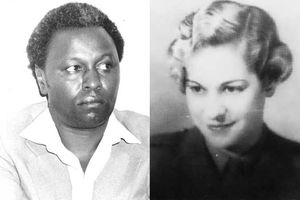Tracking peace in Todonyang

There’s complete silence in the desert. It’s close to midnight.
There are only the mountains for company – the Lapur range that stretches for miles past Lodwar to the Ethiopian border near the Ilemi triangle – a piece of land that’s remote but a lifeline for nomadic people like the Turkana.
Measuring between 10,320 and 14,000 square kilometers (about the size of Tsavo West), it’s where the Turkana bring livestock to graze when the sands turn bare.
The boundary drawn in the early 1900s, putting the land in Kenya, has been in the past contested by other countries surrounding it – Ethiopia and Sudan.
We’re in the hired Land Rover for the last 200 kilometres from Lodwar to Todonyang, a few kilometers short of the border with Ethiopia. The distance takes four hours to cover on a sand road.
At 3am, the car halts at the Our Lady Queen of Peace Todonyang Catholic Mission, perched on the flatlands between the mountains and Lake Turkana.
New tents
It’s good to meet Father Steven Ochieng again and he shows us to the beautiful new tented abode by the church.
It’s luxury compared to the camping experience five years ago, when l camped with the Hawa artists. We – Gilbert Ouma (Father Ochieng’s brother working at the National Museums of Kenya), the artists Esther Mukuhi and Carol Mbirua and I - awake at midday. Thirty-two hours by road is a long journey.
The lake lies still as a pane of glass. North Island peeps from a distance. The lakeshore is obscured by tall green reeds that weren’t there in 2006: they’ve drifted down the Omo Delta from Ethiopia.
The artists are here to continue with the workshops started by Hawa in 2006 in a quest to bring the two warring communities — the Turkana and the Merille (known as the Dassenich in Ethiopia) — together.
I pop into the quaint church to see if the mural painted by the Hawa artists is there. It’s of two men – one Turkana the other Merille - sitting on the indispensible carved stools that double up as headrests. The mural signifies peace.
After three years of peace, the old warfare has broken out because times are tough after two years without rain.
To say the least, we have a smashing time with the Turkana. The desert has so many faces. Father Ochieng drives us to a Turkana friend’s homestead an hour away in the mountains, speeding along C47 through fat sandbanks and towering earth-red anthills. Tall acacias fill the plains.
Enroute, we climb a dry river bed strewn with volcanic rocks, to Nabwin closeted in the hills. In Turkana, it’s the ‘Valley of the hyyaenas’, but there’s hardly any wildlife now.
Party in the hills
Beautiful Turkana maidens dressed in beaded finery join us. The mission has built a dam to collect the water when the torrential rains fall because fresh water is scarce.
The waters of the Jade Sea - the world’s largest permanent lake in a desert, stretching 250kms - are alkaline and unpalatable.
Some 800 homesteads depend on the dam. In the eventide, surrounded by the hills, we plunge into the cool water and even enjoy mud facials.
Atop a steep buff, is Kae Kongo, 26 kilometres from the parish. It’s the passage to the other side through which the rivers flow and a migratory corridor.
The goats have been slaughtered for nyama choma. It’s past midnight when we return to the church after dancing in the hills.




